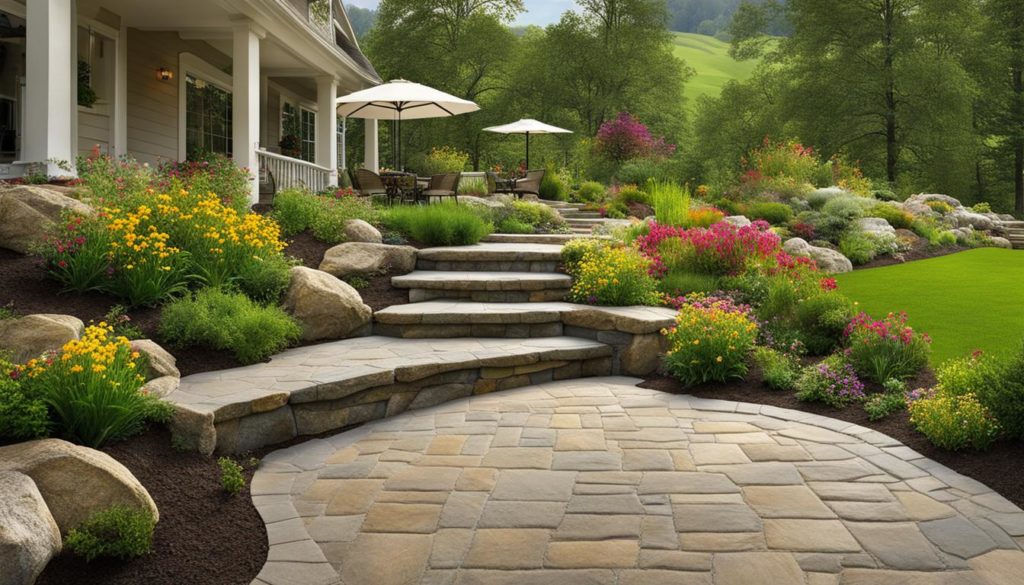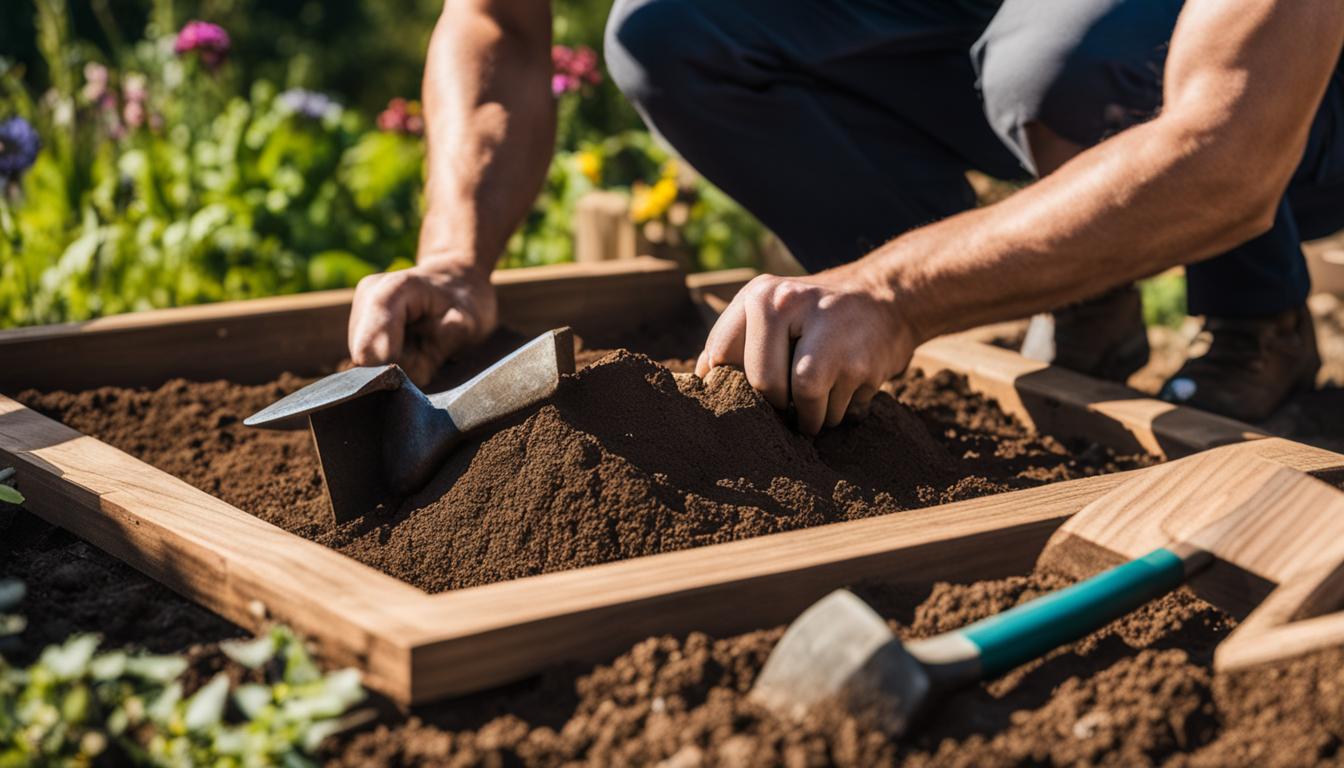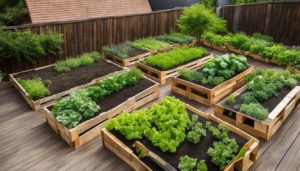A raised flower bed is a great addition to any yard, providing a beautiful and functional space for growing flowers. In this step-by-step guide, we will walk you through the process of building a raised flower bed. This guide is based on expert advice and tips, including specific instructions on choosing the location, selecting the right materials, and preparing the site. By following these steps, you will be able to create a stunning raised flower bed that adds beauty and value to your home.
Key Takeaways:
- Building a raised flower bed can enhance the beauty and functionality of your yard.
- Following a step-by-step guide is crucial for a successful project.
- Choosing the right location and materials is essential for the health of your flowers.
- Proper site preparation and soil quality are key factors in the longevity of your raised flower bed.
- By building a raised flower bed, you can enjoy the benefits of improved drainage, better control over soil quality, reduced weed growth, and easier gardening tasks.
Benefits of Raised Flower Beds
Raised flower beds offer numerous benefits that make them a popular choice among gardeners. Not only do they add visual appeal to your garden, but they also provide practical advantages. Here are some of the key benefits of raised flower beds:
Better Drainage and Erosion Prevention
Raised flower beds are designed to provide excellent drainage, ensuring that excess water does not accumulate around the plant roots. The elevated structure allows water to flow freely, preventing waterlogging and potential root rot. Additionally, raised beds help prevent soil erosion, as the walls of the bed contain the soil and prevent it from being washed away by heavy rainfall.
Extended Growing Season
One of the significant advantages of raised flower beds is that they warm up more quickly in the spring, allowing you to start planting earlier and extend the growing season. The raised structure absorbs heat more efficiently, creating a warmer environment for plants. This is especially beneficial if you live in a region with a short growing season or cooler climate.
Improved Soil Control and Fertility
Raised beds offer greater control over the quality of the soil. You can choose to fill the bed with nutrient-rich soil that is tailored to the specific needs of your plants. This allows for optimal plant growth and development. Additionally, the confined space of the raised bed makes it easier to maintain and amend the soil as needed, ensuring long-term fertility.
Easier Maintenance and Weed Control
Gardening tasks become more manageable with raised flower beds. The elevated height reduces the need for excessive bending and kneeling, making it more accessible and comfortable for tending to your plants. Raised beds also help keep weeds at bay by creating a physical barrier between the soil and surrounding garden areas. This minimizes weed infestation, saving you time and effort in weed control.
| Benefits of Raised Flower Beds |
|---|
| Better Drainage and Erosion Prevention |
| Extended Growing Season |
| Improved Soil Control and Fertility |
| Easier Maintenance and Weed Control |
Choosing the Right Location for Your Raised Flower Bed
When it comes to building a raised flower bed, selecting the right location is crucial for the success of your plants. The first step is to find a spot in your yard that receives maximum sunlight throughout the day. Most flowers thrive in full sun, but if you have limited space or areas that create partial shade, don’t worry – you can still choose shade-tolerant flowers for your raised bed.
Take into consideration the sun’s path during different seasons to ensure that your flower bed will receive adequate sunlight year-round. It’s also important to avoid placing the bed near structures like fences or walls that may cast shade and inhibit plant growth. Good drainage is essential, so make sure the location you choose has proper water runoff to avoid waterlogging and root rot.
Easy accessibility for maintenance and watering is another factor to consider. You’ll want to be able to easily reach your raised flower bed for tasks like weeding, pruning, and watering. Keep this in mind when selecting the location, and ensure that it is within convenient reach from your typical gardening tools and water source.
Table: Comparing Sun Requirements for Different Flowers
| Flower Variety | Preferred Sunlight |
|---|---|
| Roses | Full Sun |
| Petunias | Full to Partial Sun |
| Marigolds | Full Sun |
| Impatiens | Partial to Full Shade |
Now that you understand the importance of choosing the right location for your raised flower bed, you can confidently move on to the next step: selecting the materials. By carefully considering the sun exposure, drainage, and accessibility, you will create an ideal environment for your flowers to thrive and add beauty to your yard.

Selecting the Right Materials for Your Raised Flower Bed
When it comes to building a raised flower bed, choosing the right materials is crucial for its durability and longevity. Opting for untreated wood, such as cedar or redwood, is a popular choice due to its natural resistance to rot and insects. These types of wood are not only durable but also add an attractive aesthetic to your garden. It’s important to avoid using painted or pressure-treated wood, as they may leach harmful chemicals into the soil, which can be detrimental to your plants’ health.
If wood is not your preference, there are other options available. Bricks, concrete blocks, and composite wood are sturdy alternatives that can withstand the elements and provide excellent support for your raised flower bed. Consider the desired height of your bed when selecting materials, ensuring they can bear the weight of the soil without bowing or collapsing.
When determining the width of your raised flower bed, it’s recommended to keep it no wider than 4 feet. This ensures easy access from all sides for planting, maintenance, and harvesting. Additionally, the depth of your bed will depend on the types of flowers you plan to grow. Deep-rooted flowers will require a minimum depth of 12 to 18 inches to thrive.
The Advantages of Different Materials for Raised Flower Beds
To help you make an informed decision, here’s a table outlining the advantages of different materials commonly used for raised flower beds:
| Material | Advantages |
|---|---|
| Untreated Wood (Cedar or Redwood) | Natural resistance to rot and insects, attractive aesthetic, durability |
| Bricks | Durable, excellent support, visually appealing |
| Concrete Blocks | Sturdy, long-lasting, provide good insulation |
| Composite Wood | Low maintenance, weather-resistant, eco-friendly |
Consider these advantages when selecting the right materials for your raised flower bed, keeping in mind your personal preferences, budget, and the specific needs of your garden.
Preparing the Site and Building Your Raised Flower Bed
Before you start building your raised flower bed, it’s essential to properly prepare the site. Clear away any grass or vegetation in the chosen area and ensure the ground is level. If needed, use paver sand or gravel to create a smooth and even surface.
To prevent soil erosion and weed growth, line the bottom of the bed with a weed barrier cloth or a raised bed liner. This will help maintain the integrity of your raised flower bed and provide a stable foundation for your plants.
Next, it’s time to fill your raised flower bed with high-quality soil. Ensure that the soil is loose and well-draining, as this will promote healthy root growth and prevent waterlogged conditions. Consider adding compost or other organic amendments to enrich the soil and provide essential nutrients for your plants.
Finally, it’s time to start building your raised flower bed. Follow the instructions and best practices for the selected materials to ensure stability and support. Whether you’re using untreated wood, bricks, concrete blocks, or composite wood, make sure the height and width of the bed meet your needs.
| Materials | Pros | Cons |
|---|---|---|
| Untreated wood (cedar or redwood) | Durable, rot-resistant | May be more expensive |
| Bricks | Aesthetically pleasing, long-lasting | May require professional installation |
| Concrete blocks | Sturdy, easy to stack | May need additional reinforcement |
| Composite wood | Low maintenance, eco-friendly | May not have a natural wood appearance |
Once your raised flower bed is built, you’re ready to start planting! Follow the specific planting instructions for your chosen flowers, taking into account spacing, sunlight requirements, and watering needs. With proper care and maintenance, your raised flower bed will provide a beautiful and thriving garden space for years to come.
Conclusion
Building a raised flower bed is a rewarding project that allows you to create a beautiful and functional space for growing flowers. By following this step-by-step guide, you have learned the key considerations, materials, and techniques required to build a successful raised flower bed.
Remember to choose a suitable location for your raised flower bed, ensuring it receives maximum sunlight and has good drainage. Select the right materials, such as untreated wood or bricks, that are durable and safe for your plants. Properly prepare the site by clearing away vegetation, leveling the ground, and lining the bottom of the bed to prevent weed growth. Fill the bed with high-quality soil, enriched with compost if desired, to provide the best growing conditions for your flowers.
With proper care and maintenance, your raised flower bed will provide a stunning display of flowers and enhance the overall beauty of your garden. Enjoy the benefits of a flourishing garden by starting your raised flower bed today. Happy gardening!
FAQ
What are the benefits of building a raised flower bed?
Raised flower beds offer better drainage and prevent erosion, extend the growing season, allow for better control over soil quality, make gardening tasks easier, help keep weeds at bay, and create an organized and visually appealing garden space.
How do I choose the right location for my raised flower bed?
Choose a sunny spot in your yard that receives maximum sunlight throughout the day. Consider the sun’s path throughout the seasons and ensure good drainage and easy accessibility for maintenance and watering.
What materials should I use for my raised flower bed?
Opt for untreated wood like cedar or redwood, bricks, concrete blocks, or composite wood. Make sure the materials can support the weight of the soil and choose a width of no more than 4 feet for easy access. The depth depends on the types of flowers you plan to grow.
How do I prepare the site and build my raised flower bed?
Clear away grass or vegetation, level the ground, create a level surface with paver sand or gravel if needed, line the bottom with weed barrier cloth or a raised bed liner, fill the bed with high-quality soil, and follow the instructions and best practices for stability and support of the selected materials.


